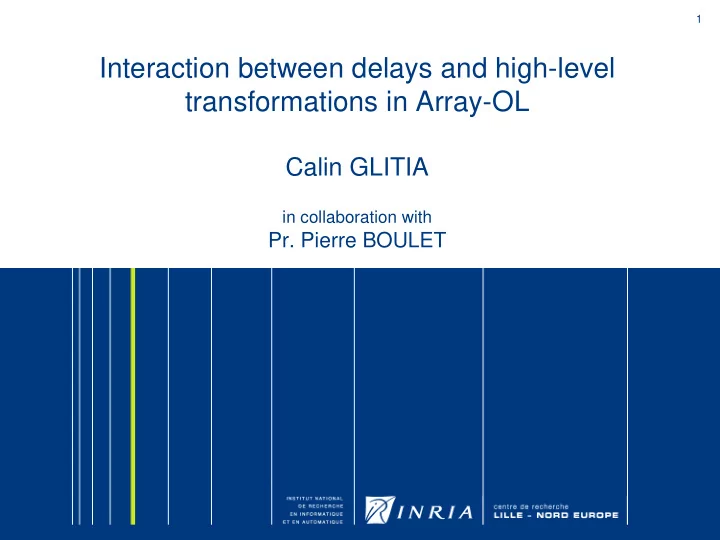

1 Interaction between delays and high-level transformations in Array-OL Calin GLITIA in collaboration with Pr. Pierre BOULET
2 Outline • Introduction • Array-OL model of specification • High-level transformations • Inter-repetition dependence extension • Interaction between the dependences and the transformations • Conclusions
3 Introduction • Computation intensive multidimensional applications • A good specification language: Expressive • Without compromising the usability • Allows a static schedule on parallel architectures • • Expressivity: Access via sub-arrays • Support for sliding windows • Cyclic data accesses • Several sampling rates • Hierarchical constructions • Express delays and state constructions •
4 Array-OL model of specification • Graphical-textual language • Focused on expressivity • Separate the specification from execution Uniform data processing • Time as dimension(s) of the data-structures • Single assignment formalism • • Express maximum of parallelism Task parallelism • – Hierarchical component-based model Data parallelism • – Repetitions (parallel by default) – Access to sub-arrays (patterns) expressed by Tilers
5 Downscaler Example
6 Array-OL transformations • Applicative optimizations Reduce intermediary arrays • Increase task parallelism • Allow a pipeline execution • • Fusion transformation Compute common repetition • Minimize intermediary array • Hierarchy creation • • Other transformations Adjustment of the granularity of parallelism • – Change paving, Tiling, Collapse By a redistribution of repetitions through the hierarchy levels •
7 Downscaler after fusion
8 Inter-repetition dependences • Uniform dependences between repetitions Dependence vector • Default values connector • – Eventual Tiler - different default values for different repetitions
9 Example of tilling • Splitting the repetition space into blocks of (5,4) Initial depending repetitions on the same hierarchy level • Result: depending repetitions in different blocks • • How to express such dependences? Connections between dependences on different levels •
10 Inter-repetition dependences connected through the hierarchy
11 Multiple dependences/default connectors example: before transformation
12 Multiple inter-block dependences • Dependence window intersects three other blocks Multiple dependences on block level • Multiple default connectors on lower level • • Choosing the right dependence done through Tilers
13 After transformation
14 Interaction with the transformations • Array-OL transformations can be seen as a redistribution of repetitions between hierarchy levels • A transformation effects only maximum two successive hierarchy levels: Interchange of repetitions between the two • Hierarchy creation • Hierarchy suppression • • Automatic post-transformation stage to adapt the dependences • Impact on inter-repetition dependences Dependence creation/suppression • Dependence vector modification • Dependence relocate •
15 Conclusions • Inter-repetition dependence extension Can express delays and state constructions • Complex dependences through the hierarchy • Model state machines for control • Repeated interconnected architectures (grid of processors) • • Reduced impact on Array-OL transformations Facilitate the implementation • • Marte OMG (Modeling and Analysis of Real-Time Embedded Systems) Standard UML Profile • Gaspard2 • Model Transformations • Code Generation •
Recommend
More recommend